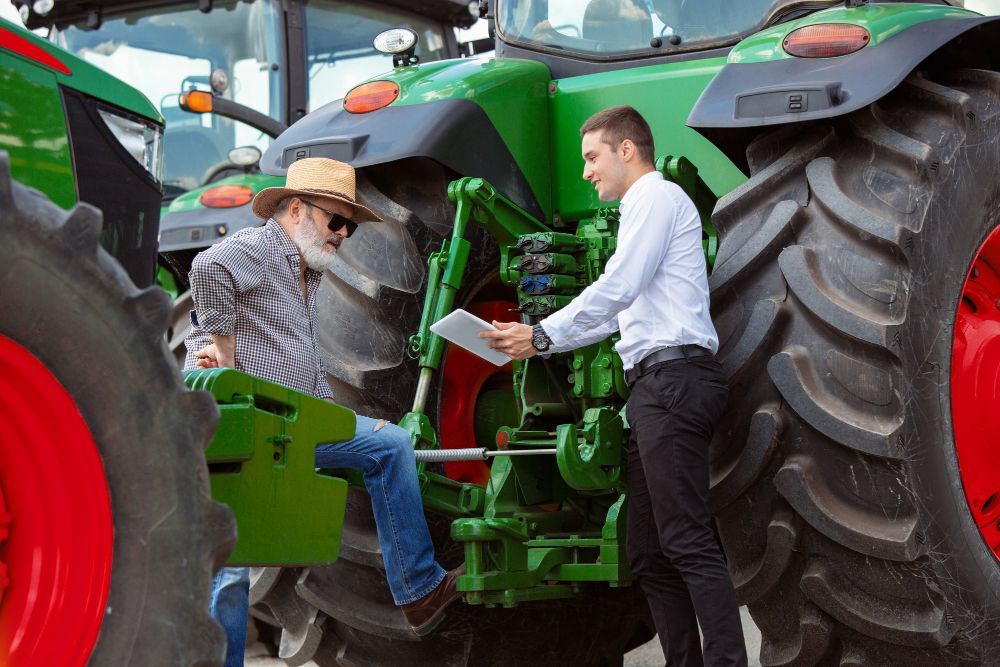
Buying a tractor: Leasing, installment plan or financing?
Buying a tractor is expensive - is leasing or installment plan worthwhile?
Tractors are one of the most important operating resources for an agricultural business. However, a new purchase is expensive and must therefore be carefully considered and planned. In addition to buying, more and more machinery dealers are also offering leasing or installment plan of tractors. But what are the advantages and disadvantages? We explain it to you.
Leasing: Temporary tractor
Leasing is already common practice for cars. But leasing is also becoming increasingly popular for tractors. But what is leasing anyway? With leasing, the dealer lets the farmer use the machine for a fixed period in return for monthly installments. The amount of the leasing rate is based on the purchase price and the calculated depreciation. At the end of the term, there are three options: You can return the machine, extend the contract on new terms or take over the machine after paying the residual value.
In contrast to financing, leasing has several advantages: The fact that you can also return the machine at the end of the leasing period means that you are always kept up to date with the latest technology - this is particularly attractive for contractors in order to offer a modern portfolio of machines. Many contractors also appreciate the fact that the monthly installments for the tractor can be paid for by the income generated by the machine. In addition, the leasing contract often includes the ongoing costs for maintenance and insurance. As the financing is off-balance sheet, the equity ratio of the business is also improved. The constant, fixed framework also enables good business planning. The disadvantage of leasing, however, is that there is much less room for negotiation on the price of the machines and the machines are more expensive when extrapolated.
Short: Leasing
Advantages:
- State-of-the-art machines
- Financing even with low liquidity
- Monthly installments can be generated by the machine
- Balance sheet-neutral investment
- Maintenance and insurance can be included
- Consistent installments
- Various options after the end of the contract
Disadvantages:
- Machines extrapolated more expensive than financing
- Machines are not transferred to the owner (option to purchase often available at the end of the contract)
Installment plan: long-term planning
Farmers who have low liquidity but would like to purchase a new tractor in the long term are often interested in installment plan. The difference to leasing is that with installment plan, the machine automatically becomes the legal property of the farmer after payment of the last installment and the economic ownership even remains with the farmer from the start. It is therefore a classic installment purchase contract. This means that the machine can be entered directly as a fixed asset in the balance sheet, the tractor can be deducted for tax purposes and the financing interest can be claimed as an operating expense. The fixed installments also make budget planning easier and enable the purchase of a tractor even if the company's liquidity is low. In contrast to leasing, installment plan is less flexible, as the tractor automatically becomes your property. In addition, as with leasing, a tractor on installment plan is usually somewhat more expensive than if you finance it through the bank or with equity, as there is less room for negotiation.
Short: Installment plan
Advantages:
- Financing even with low liquidity
- Machine becomes your property with the last installment
- Machine can be tax-deductible Consistent installments
Disadvantages:
- Machines more expensive than financing
- Less flexible than leasing
- Financial losses if the contract is terminated prematurely
Financing: Classics
A classic option when purchasing an expensive machine is financing via the customer's bank or a bank arranged by the dealer. When the purchase contract is signed, the farmer becomes the direct owner of the tractor and gradually pays the loan installments to the bank, which in return often deposits the vehicle title as security.
The advantage of financing is the cost: In contrast to leasing or installment plan, you can often negotiate with the dealer so that the machine ultimately costs less than with other financing methods. In addition, it is often possible to repay the loan earlier if the business is doing well. In the event of economic hardship or if the farm is given up, it is also possible to sell the tractor and use the sale value to pay off the remaining installments.
However, financing also has disadvantages: On the one hand, a certain percentage of equity must often be available in order to even be considered for a loan from a trustworthy institution. For large sums of money, many banks also require additional collateral, e.g. private guarantees. On the other hand, loans naturally put a strain on your company's credit line, which can be disadvantageous for other larger expenses (e.g. construction measures).
Short: Financing
Advantages:
- Often the most favorable financing option
- Loan can be repaid early
- Tractor can be sold to pay off remaining installments
Disadvantages:
- Equity must be available
- Additional collateral is often required
- Credit line is charged